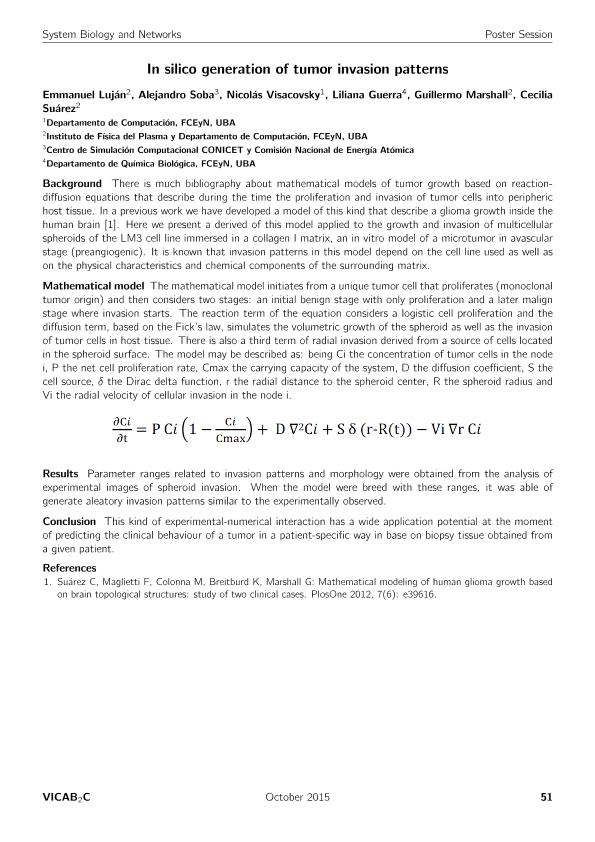Evento
In silico generation of tumor invasion patterns
Luján, Emmanuel ; Soba, Alejandro
; Soba, Alejandro ; Visacovsky, Nicolás; Guerra, Liliana Noemi
; Visacovsky, Nicolás; Guerra, Liliana Noemi ; Marshall, Guillermo Ricardo
; Marshall, Guillermo Ricardo ; Suárez, Cecilia Ana
; Suárez, Cecilia Ana
 ; Soba, Alejandro
; Soba, Alejandro ; Visacovsky, Nicolás; Guerra, Liliana Noemi
; Visacovsky, Nicolás; Guerra, Liliana Noemi ; Marshall, Guillermo Ricardo
; Marshall, Guillermo Ricardo ; Suárez, Cecilia Ana
; Suárez, Cecilia Ana
Tipo del evento:
Congreso
Nombre del evento:
VI Argentinian Conference of Bioinformatics and Computational Biology
Fecha del evento:
14/10/2015
Institución Organizadora:
Universidad Nacional del Sur;
Título del Libro:
VI Argentinian Conference on Bioinformatics and Computational Biology
Editorial:
Universidad Nacional del Sur
Idioma:
Inglés
Clasificación temática:
Resumen
There is much bibliography about mathematical models of tumor growth based on reaction-diffusion equations that describe during the time the proliferation and invasion of tumor cells into peripheric host tissue. In a previous work we have developed a model of this kind that describe a glioma growth inside the human brain (Suárez et al 2012). Here we present a derived of this model applied to the growth and invasion of multicellular spheroids of the LM3 cell line immersed in a collagen I matrix, an in vitro model of a microtumor in avascular stage (preangiogenic). It is known that invasion patterns in this model depend on the cell line used as well as on the physical characteristics and chemical components of the surrounding matrix. The mathematical model initiates from a unique tumor cell that proliferates (monoclonal tumor origin) and then considers two stages: an initial benign stage with only proliferation and a later malign stage where invasion starts. The reaction term of the equation considers a logistic cell proliferation and the diffusion term, based on the Fick's law, simulates the volumetric growth of the spheroid as well as the invasion of tumor cells in host tissue. There is also a third term of radial invasion derived from a source of cells located in the spheroid surface. Parameter ranges related to invasion patterns and morphology were obtained from the analysis of experimental images of spheroid invasion. When the model were breed with these ranges, it was able of generate aleatory invasion patterns similar to the experimentally observed. This kind of experimental-numerical interaction has a wide application potential at the moment of predicting the clinical behaviour of a tumor in a patient-specific way in base on biopsy tissue obtained from a given patient.
Palabras clave:
TUMOR INVASION
,
Modelling
,
In Silico
Archivos asociados
Licencia
Identificadores
Colecciones
Eventos(CSC)
Eventos de CENTRO DE SIMULACION COMPUTACIONAL P/APLIC. TECNOLOGICAS
Eventos de CENTRO DE SIMULACION COMPUTACIONAL P/APLIC. TECNOLOGICAS
Eventos(INFINA)
Eventos de INST.DE FISICA DEL PLASMA
Eventos de INST.DE FISICA DEL PLASMA
Citación
In silico generation of tumor invasion patterns; VI Argentinian Conference of Bioinformatics and Computational Biology; Argentina; 2015; 1-1
Compartir



